In Situ Monitoring of Drying Process of Masonry Walls
Abstract
1. Introduction
2. Materials and Methods
2.1. Renovated Building
2.2. Thermo-Injection Method for the Drying and Sealing of Masonry Walls
2.2.1. Method Description
2.2.2. Drying Device Description
2.3. Measurements Method
- For air temperature and relative humidity measurements: three transducers (AR 252 by APAR) with an accuracy of ±0.3 °C for temperature and ±2% for relative humidity. The communication with the PLC controller was via the Modbus RS 485 protocol. Measurements were carried out in three locations, i.e., in the middle of dried room, approximately 0.5 m from the ceiling, close to the drying device inlet and close to the wet wall, approximately 10 cm from the floor.
- For wall volumetric moisture content measurements: the time-domain reflectometry device (TDR/MUX/MPTS by E-TEST) with six field probes with a maximum error of ±2% for moisture content. The locations of the probes are presented in Figure 3a. The numbering of the probes starts from the right to left. Probes were made from two sharpened acid-resistant steel rods and PCV tube and were placed in slots of 20 mm diameter and 30 cm depth filled with drilling residue for easier installation. The communication with the PLC controller was via the Modbus RS 485 protocol.
- For wall temperature measurements: six three-wire resistance temperature detectors were used with the A tolerance class, with the maximum acceptable error defined in standards lower than ±0.3 °C for the whole temperature range measured during investigation, connected through two analog input modules (XN-322-4AI-PTNI by Eaton Industries GmbH) and linked to the communication module (XN-312-GW-CAN by Eaton Industries GmbH). Stainless steel sheathed probes with a diameter of 4.5 mm were placed in 30 cm-deep slots in locations presented in Figure 3a. The numbering of the probes starts from the right to left. The communication with the PLC controller was via the CANopen protocol.
- For electrical parameters measurements: the 1-phase power network meter (N27P by LUMEL) with 32/63 A measurement range was used. The meter allowed for the measurements of: current (basic error ±0.2%), voltage (basic error ±0.2%), frequency (basic error ±0.2%), active power (basic error ±0.5%), reactive power (basic error ±0.5%), apparent power (basic error ±0.5%), active energy (basic error ±0.5%) and reactive energy (basic error ±0.5%). Communication with the PLC controller was via the Modbus RS 485 protocol.
3. Results and Discussion
4. Conclusions
- The drying process resulted in the increase of the drying zone temperature up to 40–55 °C depending on the distance from the heating probes. After six days of drying, the wall temperature attained stabilization.
- The moisture was effectively removed from the wall. After six days of drying, the moisture content dropped to a mean level of 3.76% vol. (2.35% wt.), which is a value that allows effective impregnation of the wall with the hydrophobic silicone micro-emulsion. This fluid is used to create horizontal and vertical waterproofing in the wall. Moreover, the high temperature of the wall not only facilitated moisture removal, but also helped in the infiltration of the wall by the hydrophobic fluid.
- The energy consumption during the process was equal to 208.6 kWh. This value included heating and working of fans. The new parameter, i.e., the specific energy consumption, was also defined to refer to the energy consumption to the amount of moisture removed from the wall. For the considered wall, it was equal to 11.08 kWh/MC%/m.
Author Contributions
Funding
Conflicts of Interest
References
- De Santoli, L.; Mancini, F.; Rossetti, S.; Nastasi, B. Energy and system renovation plan for Galleria Borghese, Rome. Energy Build. 2016, 129, 549–562. [Google Scholar] [CrossRef]
- Phillipson, M.C.; Baker, P.H.; Davies, M.; Ye, Z.; McNaughtan, A.; Galbraith, G.H.; McLean, R.C. Moisture measurement in building materials: An overview of current methods and new approaches. Build. Serv. Eng. Res. Technol. 2007, 28, 303–316. [Google Scholar] [CrossRef]
- Válek, J.; Kruschwitz, S.; Wöstmann, J.; Kind, T.; Valach, J.; Köpp, C.; Lesák, J. Nondestructive Investigation of Wet Building Material: Multimethodical Approach. J. Perform. Constr. Facil. 2010, 24, 462–472. [Google Scholar] [CrossRef]
- Fidríková, D.; Greif, V.; Dieška, P.; Štofanik, V.; Kubičár, L.; Vlčko, J. Monitoring of the temperature-moisture regime in St. Martin’s Cathedral tower in Bratislava. Environ. Earth Sci. 2013, 69, 1481–1489. [Google Scholar] [CrossRef]
- Zegowitz, A.; Renzl, A.; Hofbauer, W.; Meyer, J.; Kuenzel, H. Drying behaviour and microbial load after water damage. Struct. Surv. 2016, 34, 24–42. [Google Scholar] [CrossRef]
- Walker, R.; Pavía, S. Thermal and moisture monitoring of an internally insulated historic brick wall. Build. Environ. 2018, 133, 178–186. [Google Scholar] [CrossRef]
- Rymarczyk, T.; Sikora, J.; Tchórzewski, P. Implementation of electrical impedance tomography for analysis of building moisture conditions. COMPEL Int. J. Comput. Math. Electr. Electron. Eng. 2018, 37, 1837–1861. [Google Scholar] [CrossRef]
- Cieślikiewicz, Ł.; Łapka, P.; Mirowski, R.; Wasik, M.; Kubiś, M.; Pietrak, K.; Furmański, P.; Seredyński, M.; Wiśniewski, T. Development of the experimental stand for investigation of the drying process in moist walls. IOP Conf. Ser. Mater. Sci. Eng. 2019, 660, 012021. [Google Scholar] [CrossRef]
- Hoła, A.; Sadowski, Ł. A method of the neural identification of the moisture content in brick walls of historic buildings on the basis of non-destructive tests. Autom. Constr. 2019, 106, 102850. [Google Scholar] [CrossRef]
- Hoła, A.; Sadowski, Ł. Verification of a nondestructive method for assessing the humidity of saline brick walls in historical buildings. Appl. Sci. 2020, 10, 6926. [Google Scholar] [CrossRef]
- Orr, S.A.; Fusade, L.; Young, M.; Stelfox, D.; Leslie, A.; Curran, J.; Viles, H. Moisture monitoring of stone masonry: A comparison of microwave and radar on a granite wall and a sandstone tower. J. Cult. Herit. 2020, 41, 61–73. [Google Scholar] [CrossRef]
- Hoła, A. Methodology for the in situ testing of the moisture content of brick walls: An example of application. Arch. Civ. Mech. Eng. 2020, 20, 1–13. [Google Scholar] [CrossRef]
- Cabrera, V.; López-Vizcaíno, R.; Yustres, Á.; Ruiz, M.Á.; Torrero, E.; Navarro, V. A functional structure for state functions of moisture transfer in heritage building elements. J. Build. Eng. 2020, 29. [Google Scholar] [CrossRef]
- Van Belleghem, M.; Steeman, M.; Janssen, H.; Janssens, A.; De Paepe, M. Validation of a coupled heat, vapour and liquid moisture transport model for porous materials implemented in CFD. Build. Environ. 2014, 81, 340–353. [Google Scholar] [CrossRef]
- Seredyński, M.; Wasik, M.; Łapka, P.; Furmański, P.; Cieślikiewicz, Ł.; Pietrak, K.; Kubiś, M.; Wiśniewski, T.S.; Jaworski, M. Analysis of Non-Equilibrium and Equilibrium Models of Heat and Moisture Transfer in a Wet Porous Building Material. Energies 2020, 13, 214. [Google Scholar] [CrossRef]
- Berardi, U.; Tronchin, L.; Manfren, M.; Nastasi, B. On the effects of variation of thermal conductivity in buildings in the Italian construction sector. Energies 2018, 11, 872. [Google Scholar] [CrossRef]
- Kubiś, M.; Pietrak, K.; Cieślikiewicz, Ł.; Furmański, P.; Wasik, M.; Seredyński, M.; Wiśniewski, T.S.; Łapka, P. On the anisotropy of thermal conductivity in ceramic bricks. J. Build. Eng. 2020, 31. [Google Scholar] [CrossRef]
- Matuszewska, M.; Matuszewski, T. Method of Uniformly Heating Holes in a Masonry Wall during Drying Same and Protecting It against Absorption of Moisture as well as Heating Element Therefor. Polish Patent 184012, 3 October 1997. [Google Scholar]
- Matuszewski, T. Method for Drying and Protecting the Walls against Repeated Rising Damp. Polish Patent 219284, 30 September 2009. [Google Scholar]
- Matuszewski, T.; Olędzki, M. Method for Drying Walls and Protect Them from Moisture Afresh. Polish Patent 223771, 31 October 2012. [Google Scholar]

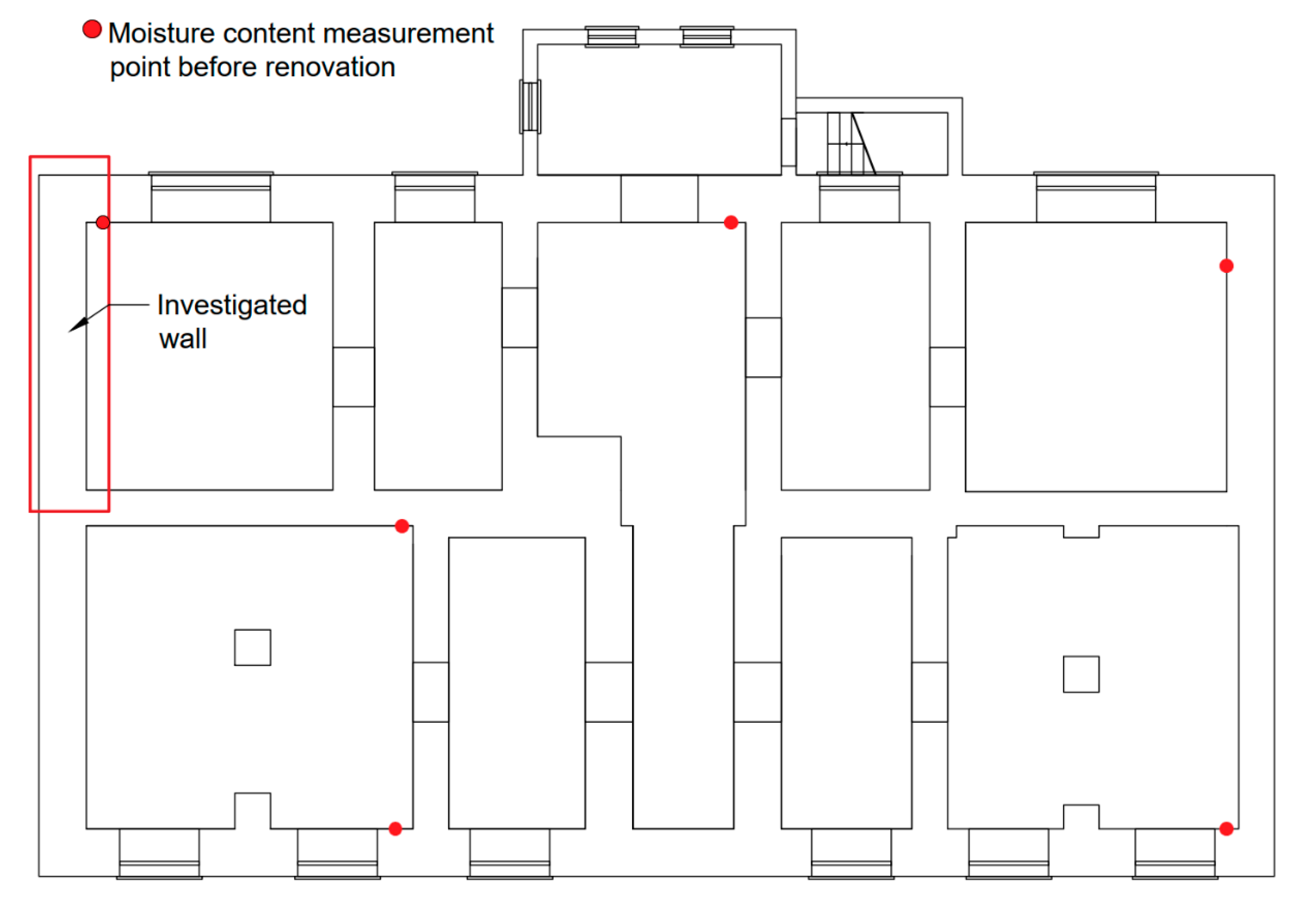

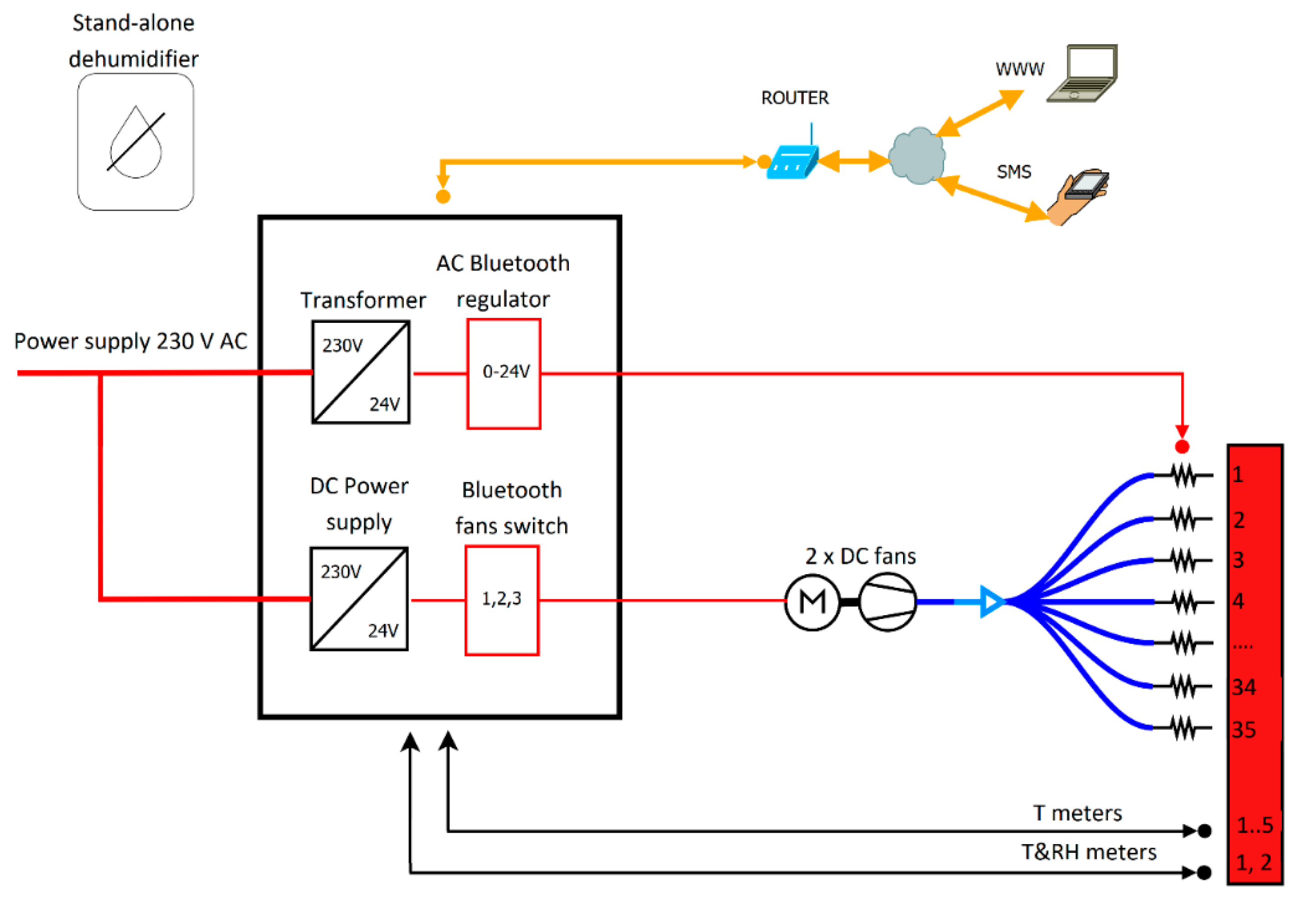
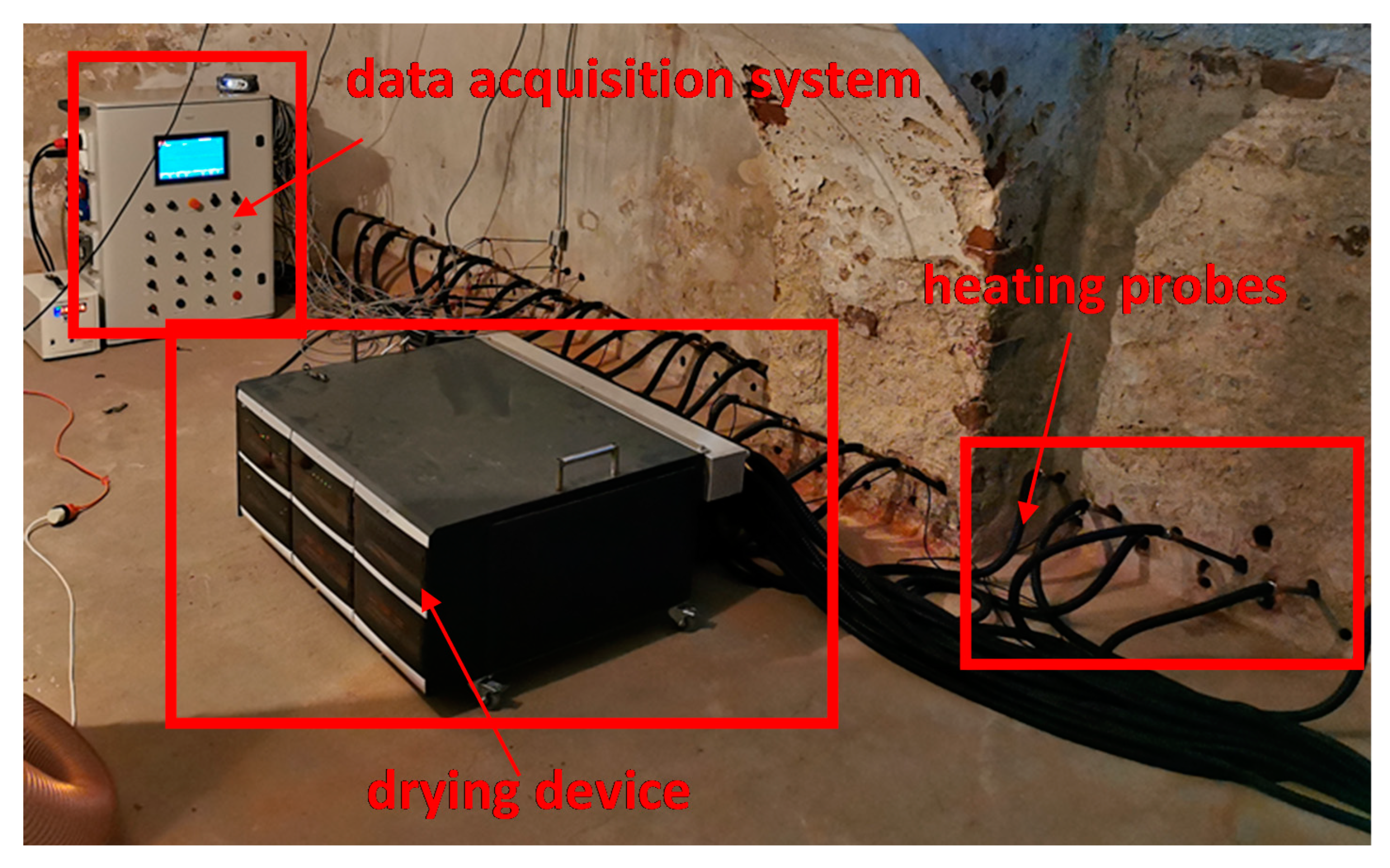
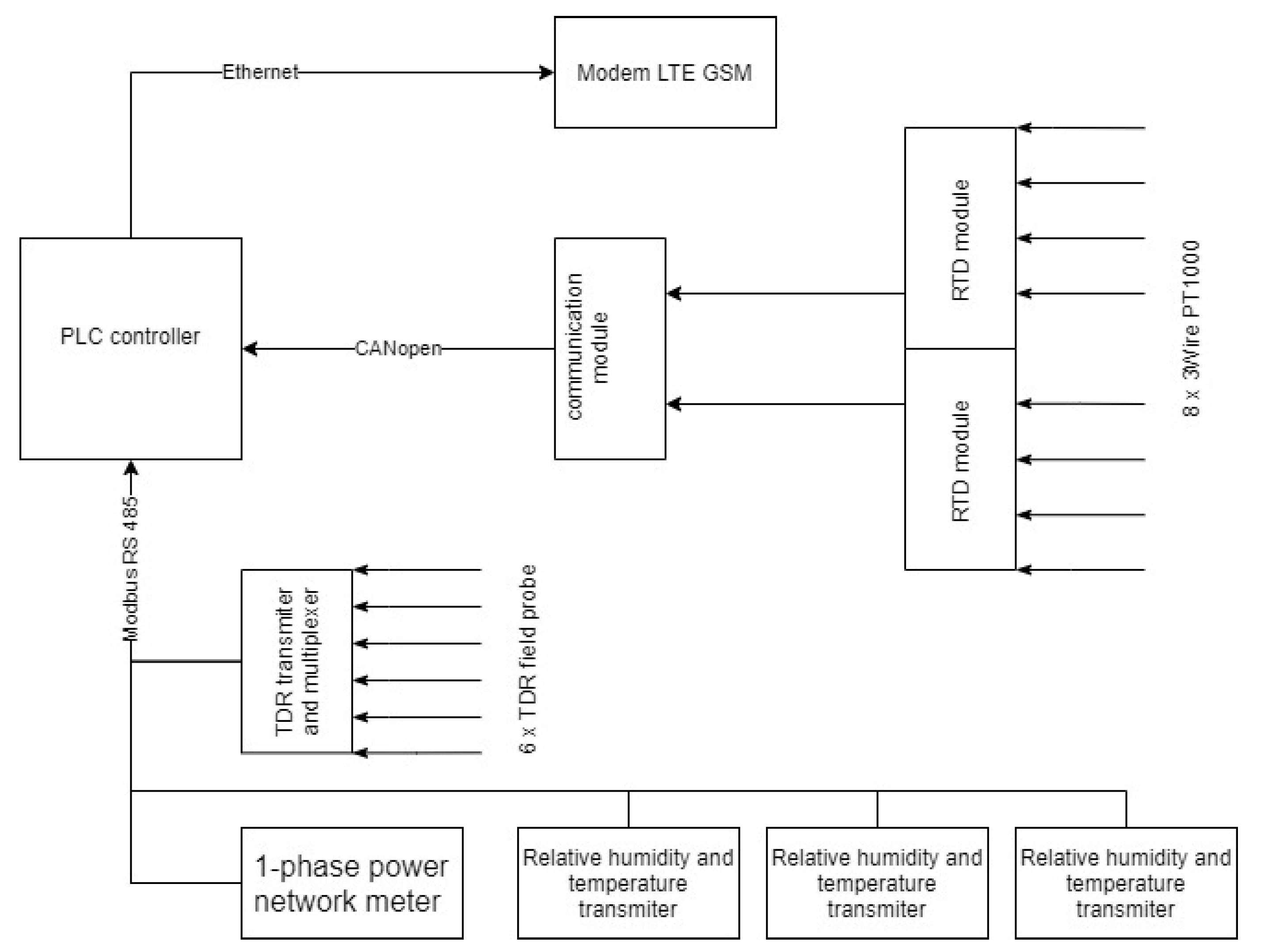
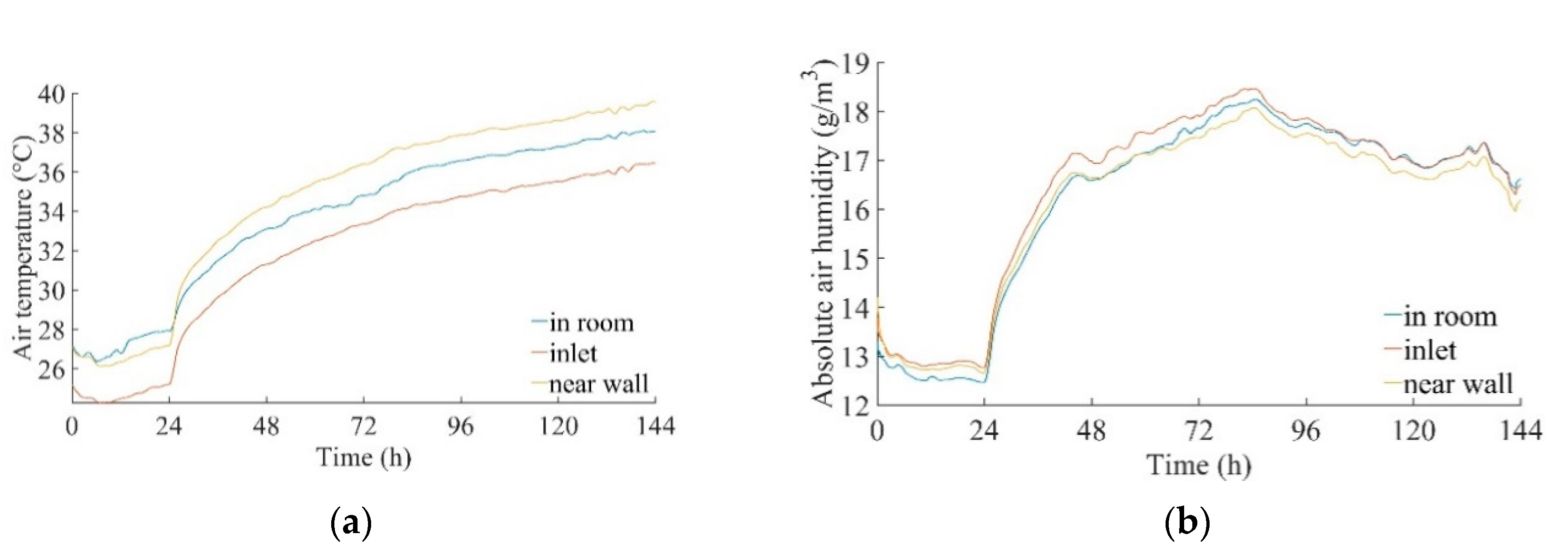
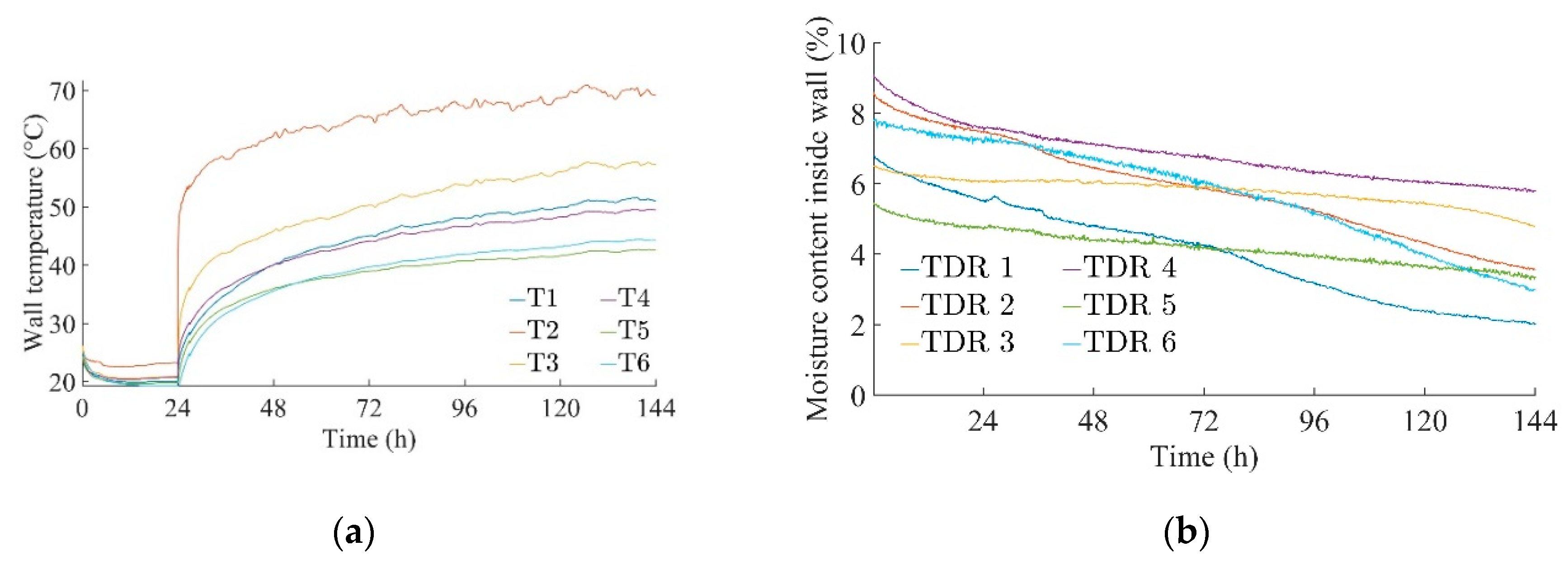

| Parameter | Unit | Value |
|---|---|---|
| Specific energy consumption | kWh/MC%/m | 11.08 |
| Mean moisture content reduction | % vol. (% wt.) | 3.77 (2.35) |
| Energy consumption | kWh | 208.6 |
| Mean active power without heaters | W | 241 |
| Mean apparent power without heaters | VA | 405 |
| Mean reactive power without heaters | VAr | −325 |
| Mean power factor without heaters | - | 0.595 |
| Mean active power with heaters | W | 1 688 |
| Mean apparent power with heaters | VA | 1 725 |
| Mean reactive power with heaters | VAr | −356 |
| Mean power factor with heaters | - | 0.978 |
Publisher’s Note: MDPI stays neutral with regard to jurisdictional claims in published maps and institutional affiliations. |
© 2020 by the authors. Licensee MDPI, Basel, Switzerland. This article is an open access article distributed under the terms and conditions of the Creative Commons Attribution (CC BY) license (http://creativecommons.org/licenses/by/4.0/).
Share and Cite
Cieślikiewicz, Ł.; Łapka, P.; Mirowski, R. In Situ Monitoring of Drying Process of Masonry Walls. Energies 2020, 13, 6190. https://doi.org/10.3390/en13236190
Cieślikiewicz Ł, Łapka P, Mirowski R. In Situ Monitoring of Drying Process of Masonry Walls. Energies. 2020; 13(23):6190. https://doi.org/10.3390/en13236190
Chicago/Turabian StyleCieślikiewicz, Łukasz, Piotr Łapka, and Radosław Mirowski. 2020. "In Situ Monitoring of Drying Process of Masonry Walls" Energies 13, no. 23: 6190. https://doi.org/10.3390/en13236190
APA StyleCieślikiewicz, Ł., Łapka, P., & Mirowski, R. (2020). In Situ Monitoring of Drying Process of Masonry Walls. Energies, 13(23), 6190. https://doi.org/10.3390/en13236190





